The demand for milk and milk products is also increasing in the market. In such a situation, the demand for these animals, which are at the forefront of milk production, has increased. Many breeds of cows can produce more than 50 liters of milk daily. Compared to other dairy animals, cattle offer many advantages in terms of ease of milking, udder size and milk storage capacity of the animal, and milk production.
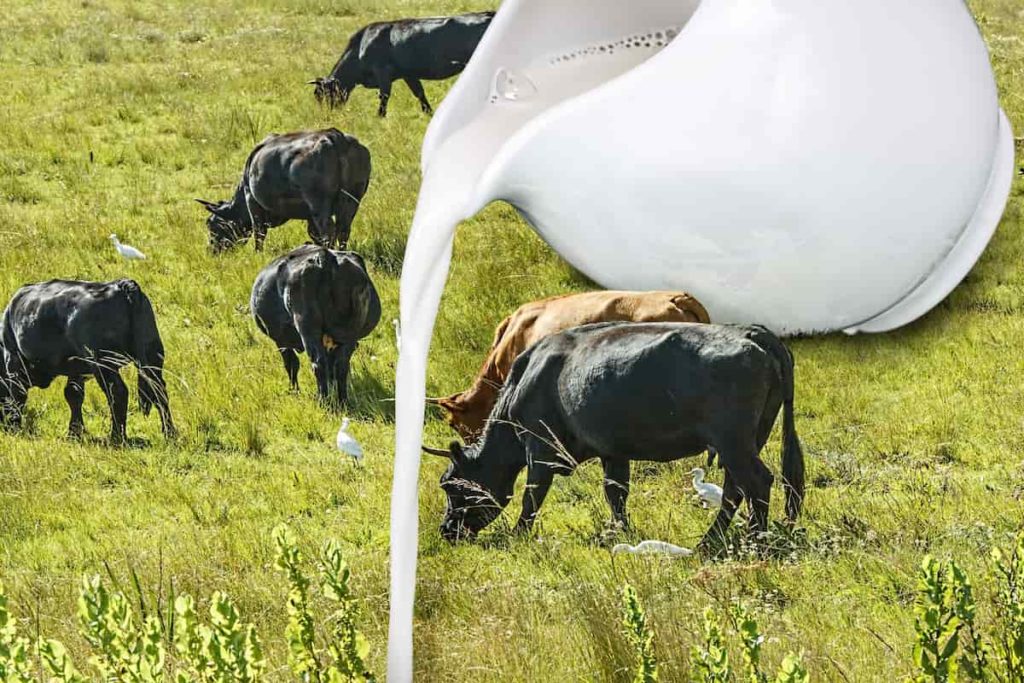
There are more dairy cows in developing countries than in developing countries, but in developing countries, the milk production of animals is lower, and milking performance is lower. Poor animal performance in small-scale dairy systems in developing countries is due to climate, low-quality feed, low concentration levels, the low genetic potential of multipurpose animals for milk production, and a high incidence of disease.
Cows will provide you and your family with homemade milk. Also, owning a dairy cow can provide another source of income if you are interested in selling milk and milk products in the market.
Top and highest milk producing Cattle/cow breeds in India
General selection procedures for dairy breeds
A dairy farmer must build his herd by breeding his own. The following guidelines will help select a dairy cow.
- An animal purchased from a cattle fair should be selected based on its breed character and milk production capacity.
- A history sheet or pedigree sheet usually kept on organized farms shows the complete history of the animal.
- Maximum production of dairy cows is observed during the first five lactations. So selection should usually be made during the first or second lactation and the month after calving.
- There is successive complete milking, and its average gives a fair estimate of the yield of a particular animal. A cow should allow anyone to milk it, and it should be polite. It is best to buy animals in October and November. Maximum yield is observed 90 days after calving.
- Proper selection is the first and most important step adopted in dairying. Records are the basis of selection, so proper identification and record keeping of animals are essential.
- There are many options when choosing a family dairy cow or among the best dairy breeds to start a small dairy. The most “ideal” breed will be the one that suits your circumstances and purpose. Once you’ve decided which breed of dairy cow best suits your needs, there are several ways to get started with a small dairy or family dairy cow.
- You can buy an adult animal that has calved and produced milk or a pregnant cow or heifer that will soon calve. Or, if you’re not in a hurry, you can buy a breeding cow, or even a calf, to raise. A baby calf will be the cheapest to buy, but you must feed it for a few years and find a way to breed it. The most expensive animal will be the high-producing young cow. If you want to get a cow just for the raw milk benefits or have a family dairy cow, however, you can choose a gentle cow with several calves or a middle-aged cow, averaging with milk production. It’s easiest if you’ve never had a dairy cow before. To start with a cow, you must calve her and train her to milk.
Points to consider when choosing a dairy cow
- Environmentally friendly.
- Important environmental parameters such as rainfall and temperature should be considered.
- Availability and storage of feed resources throughout the year.
- The land size determines the number of animals you can keep. Production intensity, whether you want to raise your animals under zero or free grazing.
- An estimate of capital resources is required.
In case you missed it:Cattle Fattening Methods, Techniques, and Tips
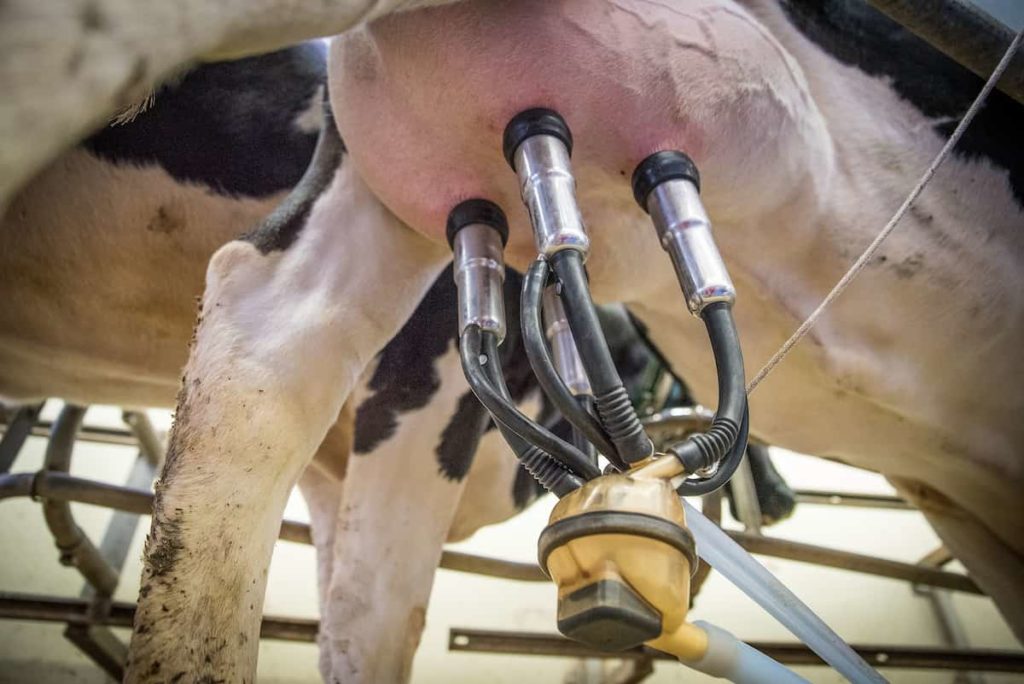
Steps to increase milk production
In addition to diet, rearing conditions and herd management directly impact the milk produced per cow per day. The first step to be implemented is to conduct an audit. The findings from this audit will help identify areas for improvement. This process will take into account various factors: nutrition, health, environment, and herd housing, focusing on the following points:
Management of reproductive problems: Poor reproductive performance extends the calf to the calving interval and, therefore, the average lactation length. As a direct effect, low reproductive efficiency can prevent food from being fully utilized.
Control of health problems: Various diseases commonly encountered in dairy herds can reduce digestive efficiency (ketosis, acidosis, fatty liver, and alkalosis) and cause disturbances in eating behaviors (acidosis, lameness), as well as affecting secretory tissues (Mastitis).
Housing Conditions: Housing should favor the best expression of the animal’s full behavioral potential. Animals must have constant access to a feed bank and drinking water. Adequate housing should also prevent diseases linked to rearing (the importance of ventilation, brightness, bedding quality, and arrangement of stalls).
Water – Provide continuous clean water with an adequate flow rate. Provide adequate water space for your cows – 1 water fountain/20 cows or 4 inches of linear space/cow. Make a routine of at least weekly water cleaning.
Cow comfort
- Provide each cow with its stall.
- Make sure there are enough beds in the stalls.
- Make sure stalls are comfortable – look for cows sitting (indicative of uncomfortable cows).
- Clean bedding from stalls weekly or as needed.
- Trim feet at least 1.5 times per year on average.
- Treat all cows with foot sores.
- Provide safe steps in all walkways.
- Provide adequate airflow for proper ventilation (heat reduction).
- Avoid winter drafts and storm penetration
General health care
- Vaccinate cows and heifers as needed.
- Check for internal parasites and regularly deworm if on pasture.
- Establish a working relationship with the veterinarian—schedule regular herd health checks.
- Consider using a photoperiod (16 hours light-8 hours dark).
- Use diagnostic laboratory services for disease problems.
- Grooved slippery floors provide restraint facilities for managing health procedures.
- Feed only good quality colostrum (> 50 g/L IgG or > 22% Brix)
- Use iodized navel on all calves after birth.
- Maintain rumen health and prevent ruminal acidosis.
- Identify dairy cows with a history of metabolic or health problems.
Nutrition management for increasing milk production
- Nutrition plays an important role in keeping livestock healthy and strong. A proper nutritional program can also improve milk production and reproductive performance. Nutritional requirements may not be the same depending on the animal’s age and stage of production. Diets are formulated to meet dairy cows’ energy and amino acid requirements for lactation, growth, and reproduction.
- Forage is anything that is specifically grown on a farm. Forages such as hay, straw, corn silage, or hay silage are the most common types of forage used. The basis of most dairy cattle diets is high-quality forage. Cereal grains, as the main starch contributors to the diet, are important in helping to meet the energy requirements of dairy cattle which is an excellent source of balanced amounts of protein, energy, and fiber.
- Provide 20 to 25 kg of green fodder. Don’t just provide one type of green fodder – try to mix legumes like hedge lucerne and cowpea with common fodder like C04, sorghum, etc. Chaff green fodder increases nutrient intake and reduces wastage.
- Provide 10 kg of dry fodder, and it is advisable to provide dry fodder after the evening milking.
- Provide 4 kg of concentrate feed and increase this amount for heavy milkers. Don’t use only 1 type of paddy for dairy cows. Mix 1 oil cake like cotton cake, groundnut cake, or whatever is locally available, 1 grain of corn as powder, and 1 husk-like black gram husk; try mixing paddy husk, etc. Soaking it overnight will ferment the feed and increase nutrition.
- Provide 50 grams of the mineral mix, and this is very important. If you don’t provide a mineral mixture, this will result in micronutrient deficiencies, reducing milk production and reproductive problems. Provide 30 liters of sanitary/pure water.
In case you missed it:Jersey Cow Farming, Feed Chart, Milk, Breed Facts
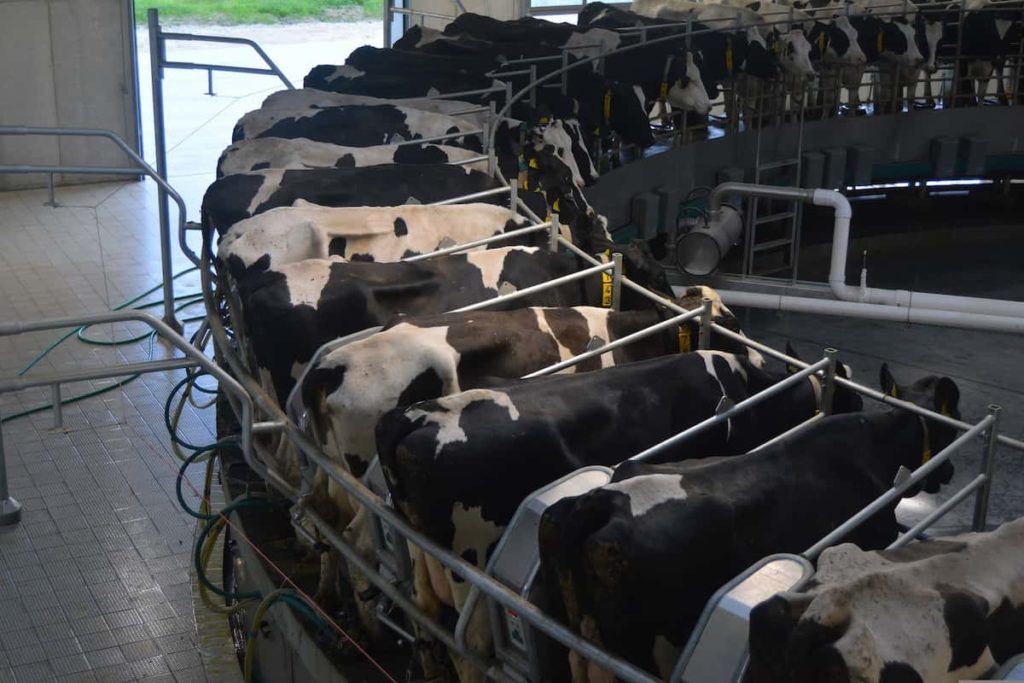
Best highest milk-producing cattle breeds
Holstein Friesian
The Holstein Friesian produces the highest milk production of all breeds worldwide. Today’s Holsteins are black and white, although some are red and white. A cow weighs about 1,500 pounds, and a bull weighs about 2,000 pounds. There are more Holsteins in the U.S. today than any other dairy breed because they produce large amounts of milk with a low butterfat content that is ideal for drinking. The Holstein is the most popular of the dairy cow breeds, with its black and white spotted body.
Holsteins are one of the largest breeds of the dairy cow. Holstein dairy cows originated in Holland and arrived in America in the 1850s. Holstein dairy cows now make up about 90 percent of the cows used for dairying in U.S. milk production. Holsteins are popular in the American dairy industry because of their high productivity. If these cows are properly cared for, they can produce about ten to twelve gallons of milk per day. Holstein dairy cows are easy to work with and are very docile.
However, because of their large size, Holsteins require a large amount of feed and a large grazing area. Holsteins, also known as Holstein Friesians, are the most popular dairy cow breed. It is the largest dairy farm animal in the world. Holstein cows are known for their gentle temperament, sweet disposition, and strong herd-following instincts. It is characterized by being the heaviest dairy cow.
They carry a large udder commensurate with their extensive production. Because of their dairy approach, Holstein’s body is wider in the back, curved, and less muscular. The Holstein breed is best suited for cold or temperate climates but is highly susceptible to heat. Their milk depends on various factors, such as nutrition and the environment. The Holstein cow produces about 23,000 pounds of milk or 2,674 gallons per lactation. A standard lactation lasting 305 days yields 75 pounds or about 9 gallons of milk per cow per day.
Gir Cow
The breed of Gir cow originates from the Gir forests of Gujarat. This breed of cow gives about 1500 kg of milk per lactation. It looks very distinctive with its curved horns. The cow weighs around 380 kg but is a calm and friendly breeding cow.
This cow is known as the highest milking cow in the country. This cow is also in demand abroad. Moreover, Gir cows are also mainly raised in Brazil and Israel. The specialty of this cow is that it gives 50 to 80 liters of milk per day.
Jersey
Jersey is the second largest dairy cattle breed raised primarily for milk production. This breed is known for its high milk production and high butter content. They are high-yielding breeds and can give more than ten times their weight per lactation. They come in all colors: dark brown, red, spotted, and light down. Whatever their color, they have dark muzzles, tails, and flanks.
They require low maintenance and have high grazing capacity due to their low body weight. Moving large numbers of Jersey cows is possible due to their low maintenance requirement and body weight. A Jersey cow gives 30-35 liters of milk per day. Yield about 5000-8000 Kg per year.
In case you missed it:Gir Cows and HF Cows; Differences, Characteristics
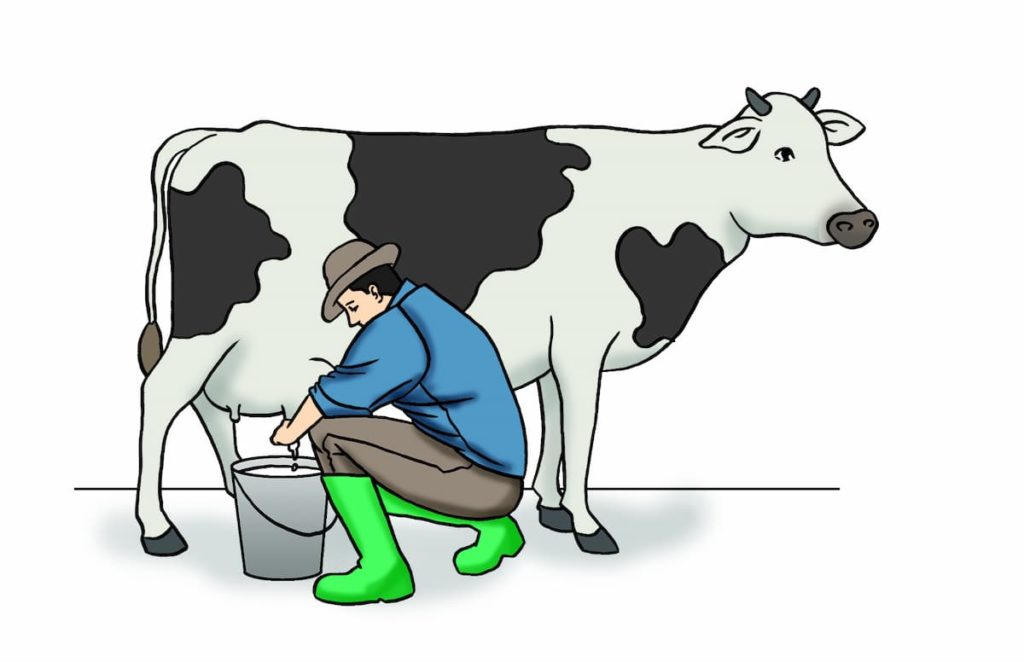
Rathi cow
This cow is found in Ganganagar, Bikaner, and Jaisalmer regions of Rajasthan, but nowadays Rathi cow is also reared in Gujarat. This breed of cow is known for high milk production. It can produce 6 to 8 liters of milk per day. Its weight is around 280 to 300 kg.
Red Sindhi Cow
This cow is found in the region of Sindh hence its name Red Sindhi Cow. This cow is also found in Punjab, Haryana, Karnataka, Tamil Nadu, Kerala, and Odisha. This cow is famous for its high milk production in the country. The breed originated from the Sindh province of Pakistan and is widely kept as a dairy cow in Pakistan, Bangladesh, and Sri Lanka. They are heat and disease-resistant. This cow can also give 2000 to 3000 liters of milk per year.
Guernsey
The breed originated over 1,000 years ago on a small island in the English Channel off the coast of France. Guernsey was developed from these cattle. Guernsey was first brought to America in 1840 and is white with yellow skin. A cow usually weighs 1,100 to 1,200 pounds, and a bull weighs about 1,700 pounds. Calves are relatively small at birth, and cows rarely have calving problems. The milk is yellow and has a lot of fat. Heifers mature early, breed quickly, and have good temperaments, making them easy to handle.
Guernsey cows provide golden-colored milk because the milk is high in beta-carotene. Guernsey cows are native to Great Britain, but many homesteaders and farmers believe that Guernsey cows are descended from two French cow breeds. Guernsey cows are perfect for hand milking and are a favorite on small farms because they are friendly and docile. Because Guernsey cows need less space to graze because of their small size. They also require less feed to keep them healthy and produce good milk. A Guernsey cow produces about 22 liters of milk a day.
Ayrshire
These originated in Scotland and were brought to America in 1822. Their color is red and white. White spots are usually spotted on the edges. Cows are medium-sized — about 1,200 pounds — and bulls weigh about 1,800 pounds. Ayrshires are known for their good udders, longevity, and hardiness. They manage well in most environments without pampering and give rich milk.
Ayrshire is recognized as the most beautiful dairy cattle breed, ranging in color from light to deep cherry red, brown, or a combination of these colors with white. Ayrshire cows are more dominant than other cow breeds. They can be difficult to handle at times, but if you have some experience with cows – you shouldn’t have too much trouble managing them.
These cows are one of the largest dairy cow breeds, and their milk production is between a Jersey cow and a Holstein cow. Because of their size, Ayrshire cows require a large grazing area and good feed to maintain their milk production and keep them healthy. These cows can produce 4 to 6 gallons of milk or more daily.
Normande
The Normande cow breed comes from a region in France called Normandy. This breed was obtained in the 19th century after crossing several breeds. Normande cows are a dual-purpose breed kept primarily for milk production and are best adapted to tropical countries. Normandy cows have white fur with colored spots, including dark brown, reddish or yellow. They have a large head with patches, which give them a glassy appearance and a black snout. Normande cows are medium-frame breeds and can weigh between 1,200 and 1,500 pounds.
The weight is due to their dual purpose status. This breed is characterized by its broad chest and belly, giving it a solid, rectangular shape. It has excellent leg structure and strong muscles necessary for meat production. Normande cows are strong and broad, well adapted for high milk production. Considering their dual-purpose phenotype, Normandy cows are excellent milk producers. Also, their milk is rich in protein and fat, which offers an advantage for cheese and butter production. They can produce 6,000-7,000 liters of milk per lactation.
In case you missed it:Red Sindhi Cow Cost, Milk Per Day, and Profile
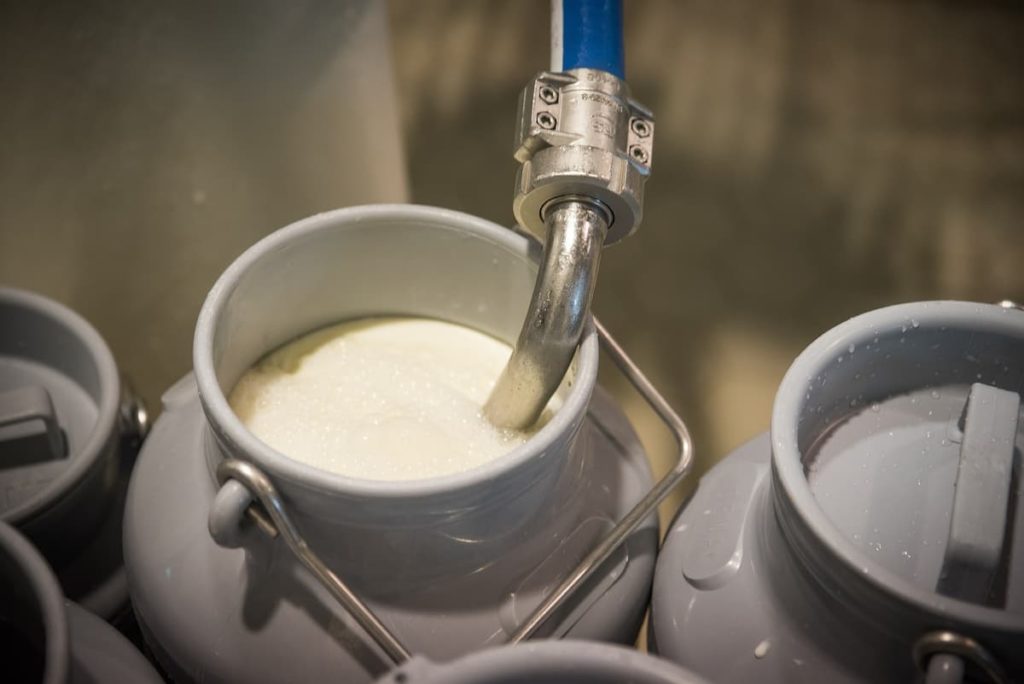
Dexter Cows
Dexter cows are very popular on small farms and homes because they are very small, but they still provide a good amount of milk for their size. Dexter cows typically reach about 3.2 feet at the shoulder when fully grown. Dexter cows are also much lighter than other cow breeds! Their small footprint can minimize damage to the soil and pasture they run on.
Dexters are also friendly creatures for which the whole family will enjoy caring. Dexter cows kept as dairy cows will yield 10 – 12 liters daily, with some individuals yielding 14 liters or more.
Dutch-Belted
It is a colorful breed (with a large white band encircling the middle of the body) and is interspersed with cattle in Switzerland and Austria. This cow is known for ease of management and milk quality; this breed set early records for butterfat. They are average-sized cattle but short-boned and easy to calve.
They have longevity and fertility, high meat production, and good temperament—characteristics that make them desirable in crossbreeding programs for grass-based dairies or small-farm meat production. However, they are rare today, and some breeders try to preserve their breed by not crossbreeding them. These cows produce an average of 35 to 40 pounds of milk daily and do so well into their teenage years.
Sahiwal cow
It is known for its excellent taste and nutritional qualities. It contains A2 protein and is very effective in producing milk. Although milk is high in fat, the pure A2 beta-casein protein makes it the cow’s milk of choice for many. Sahiwal cow’s milk is helpful in fighting cholesterol, diabetes, and heart diseases. It is a good milk producer – compared to other local breeds, and it has capable of average producing about 8-10 kgs per day.
Brown Swiss cattle breed
It is a breed of cattle popular in the production of cheese. Brown Swiss cows are usually solid brown, varying from very light to dark, and quickly spotted with their large, floppy ears. These gentle giants are close to 1,500 pounds, making them the largest dairy breeds. Brown Swiss cows are one of the oldest cow breeds in existence today. Brown Swiss cows are originally from Switzerland and arrived in America in 1869.
They are also widely considered to be the second most productive dairy cow. Their milk is perfect for making cheese because it has a close ratio of fat to protein, making the cheese fuller and creamier. These cows are remarkably gentle, friendly, and easy to handle. Brown Swiss cows are usually around the size of a Holstein cow, which means they need a lot of feed and grazing space to stay healthy and at peak milk production. Brown Swiss produces 9,000 kg of milk annually.
Swedish red cattle breed
It is popularly known as Swedish Red and White Cattle. The height of this cattle breed is 140 cm, and its weight is 600 kg. The average Swiss dairy cow produces 17.6 liters of milk a day.
Angeln Cattle Breed
This dairy cow is known for its high milk fat content. Cattle milk production benefits dairy farms and is used by many milk processing equipment and market suppliers. This cow breed is known for its high milk production. From this, milk can be obtained from 6 to 8 liters daily.
In case you missed it:Hereford Cattle Breed Facts, Profile, and Characteristics
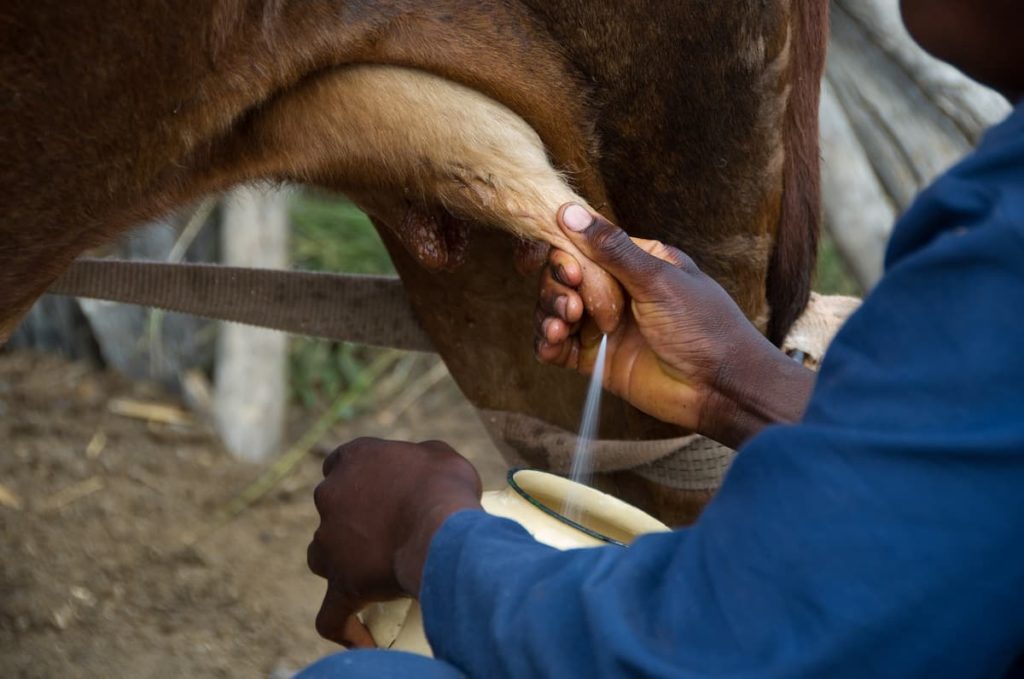
Milking Shorthorn Cattle
The Milking Shorthorn, also known as the Dairy Shorthorn, is a breed of red cattle with white markings, all white or red roan. A lactating Shorthorn has a height of 140 cm and a weight of 680 kg. A typical cow produces 15,400 lbs of milk per cycle with a butterfat content of 3.8% and a total protein of 3.3%.
Conclusion
Cow’s milk is also considered very nutritious, so it is always in demand in the market. But interestingly, very few cattle owners know that many cows in the country can produce up to 80 liters of milk per day. Milk production will be important if you raise a cow to be part of a dairy farm. On the other hand, if you only need enough milk for your family, you may not need such a high-yielding breed. Cow milk accounts for the largest share of total global milk production.
- Types of Pesticides Used in Agriculture: A Beginner’s Guide
- Economical Aquaculture: A Guide to Low-Budget Fish Farming
- 15 Common Planting Errors That Can Doom Your Fruit Trees
- How to Make Houseplants Bushy: Effective Tips and Ideas
- Innovative Strategies for Boosting Coconut Pollination and Yield
- Pollination Strategies for Maximum Pumpkin Yield
- The Complete Guide to Chicken Fattening: Strategies for Maximum Growth
- Natural Solutions for Tulip Problems: 100% Effective Remedies for Leaf and Bulb-Related Issues
- Revolutionizing Citrus Preservation: Towards a Healthier, Greener Future
- Natural Solutions for Peony Leaf and Flower Problems: 100% Effective Remedies
- Maximizing Profits with Avocado Contract Farming in India: A Comprehensive Guide
- Natural Solutions for Hydrangea Problems: 100% Effective Remedies for Leaf and Flowers
- The Ultimate Guide to Choosing the Perfect Foliage Friend: Bringing Life Indoors
- From Sunlight to Sustainability: 15 Ways to Use Solar Technology in Agriculture
- The Ultimate Guide to Dong Tao Chicken: Exploring from History to Raising
- The Eco-Friendly Makeover: How to Convert Your Unused Swimming Pool into a Fish Pond
- Mastering the Art of Delaware Chicken Farming: Essentials for Healthy Backyard Flocks
- 20 Best Homemade Fertilizers for Money Plant: DIY Recipes and Application Methods
- How to Craft a Comprehensive Free-Range Chicken Farming Business Plan
- Brighten Your Flock: Raising Easter Egger Chickens for Beauty and Bounty
- How to Optimize Your Poultry Egg Farm Business Plan with These Strategies
- Subsidy for Spirulina Cultivation: How Indian Government Schemes Encouraging Spirulina Farmers
- Ultimate Guide to Raising Dominique Chickens: Breeding, Feeding, Egg-Production, and Care
- Mastering the Art of Raising Jersey Giant Chickens: Care, Feeding, and More
- Ultimate Guide to Raising Legbar Chickens: Breeding, Farming Practices, Diet, Egg-Production
- How to Raise Welsummer Chickens: A Comprehensive Guide for Beginners
- How to Protect Indoor Plants in Winter: A Comprehensive Guide
- Ultimate Guide to Grow Bag Gardening: Tips, Tricks, and Planting Ideas for Urban Gardeners
- Guide to Lotus Cultivation: How to Propagate, Plant, Grow, Care, Cost, and Profit
- Agriculture Drone Subsidy Scheme: Government Kisan Subsidy, License, and How to Apply Online
- Ultimate Guide to Raising Araucana Chickens: Breed Profile, Farming Economics, Diet, and Care
- Bringing Hydroponics to Classroom: Importance, Benefits of Learning for School Students
- Ultimate Guide to Raising Polish Chickens: Breed Profile, Farming Economics, Diet, and Care
- Ultimate Guide to Raising Australorp Chickens: Profile, Farming Economics, Egg Production, Diet, and Care
- Silkie Chicken Farming: Raising Practices, Varieties, Egg Production, Diet, and Care
- Sussex Chicken Farming: Raising Practices, Varieties, Egg Production, Diet and Care